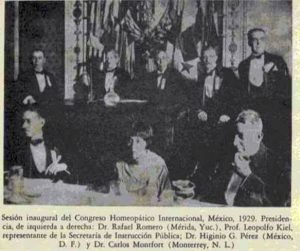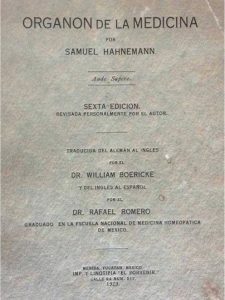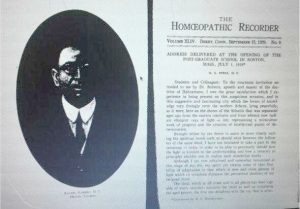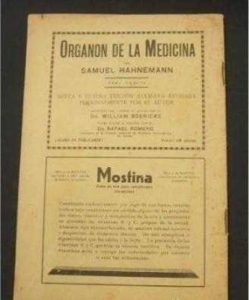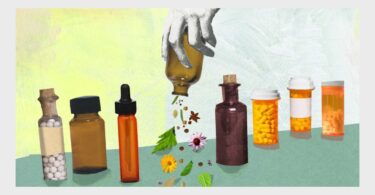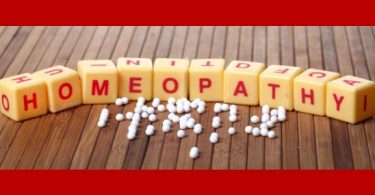January – 1880 to 1960
Translated by Katja Schuett and Alan Schmukler
Abstract
When searching for information about the Organon of Medicine in Spanish, almost always the name of Dr. Rafael Romero appears. Very few and scattered are the data that exist about this personage, inspite of his having been the first translator to the Spanish of the sixth edition of the Organon and of having worked tirelessly in favor of homeopathy. This information will help to give a broader picture of his career, an act of historical justice for someone who helped the Hispanic homeopathic world to know the latest contributions of Dr. Samuel Hahnemann.
Keywords: Doctor Rafael Romero, Organon, Homeopathy in Yucatan.
Introduction
The Organon of Medicine, authored by the German physician Samuel Hahnemann, is the work that rules the practice of homeopathic therapeutics. This book has been translated into very many languages and consists of six editions, the result revisions due to evolved ideas. The last one written by Dr. Hahnemann in 1842, was the one he himself considered to be “the most nearly perfect of all“.
This version was not printed immediately but only 79 years later, when German doctor Richard Haehl, after meticulous research and investigation sponsored by his colleague Dr. William Boericke, edited and published it in German in 1921. A year later, Dr. Boericke published it in English. To understand the newest propositions and changes made by Dr. Hahnemann with regard to the 5th edition, it was necessary to know something of the two mentioned languages.
First translation into Spanish
On occasion of the celebration of the International Homeopathic Congress, held between August 10th and 17th, 1929, in Mexico City – an event that took place one hundred years after the First Homeopathic Congress chaired by Dr. Hahnemann – the Organon of Medicine, translated into Spanish by the Yucatan Dr. Rafael Romero [1,2] was presented.
When looking for information about the Spanish editions of the Organon of Medicine, the name of Dr. Romero almost always appears. In spite of that, very little is known about his career and the great contribution he made. Hence, the desire to fnd information about him, which is very scattered, and to compile it in a single document, a biografical sketch of the man. He was the person who informed the Spanish-speaking homeopathic world about the latest contributions of Dr. Hahnemann. The translation of the 6th edition of the Organon of Medicine into Spanish by Dr. Romero was the second of this work translated into another language than German, the first being, in English, which gives even more merit to his work.
First steps
Dr. Rafael Romero was born in the city of Mérida, in Yucatán, on Wednesday, January 15th, 1880 [3]. He studied medicine at the National School of Homeopathic Medicine in Mexico City, and graduated there on May 6th, in 1907[4], being influenced by the Yucatan physician Rafael Villamil, who had converted to homeopathy.
Dr. Romero went back to his homeland and immediately began his activities to promote this therapy based on the law of similars. He worked as an editor and collaborator of the journal La Reforma Médica de Mérida, Yucatán, in 1908 (first epoch), a publication that didn’t fluorish and closed its doors on January 15th, 1909[5].
In the same year he published a book called La seroterapia (Serotherapy) whose central thesis was that “serotherapy, in its current state, is a defective and imperfect application of homeopathy.” This book has been commented on in the French journal Le Propagateur de l´Homeopathie [6].
Dr. Romero was convinced that to spread the knowledge and use of homeopathy it was necessary to have media for distribution, wherefore he founded a monthly publication with the name of Revista Hahnemanniana, (Hahnemannian Journal) which was published for one year, from 1909 to 1910[7].
That same year he sent an article to the journal Homeopathic Recorder, with the title of Homeopathic remedies hypodermically administered, which unleashed an intense debate that can be read in the same journal, in the July issue[8]. Dr. Rafael Romero replied to the comments with a letter titled: Confusion of the law of similitude with the channels of introduction and doses of the remedies, a reply to Dr. C. M. Boger, of Parkersburg, and Dr. Pompe, of Vancouver [9].
On February 19th, 1912, the journalist Carlos R. Menéndez requested that the Publishing Company Peninsular, S.A., which was in charge, publish the journal La Revista de Yucatán. Dr. Romero was the second voice on the board of directors and owner of 4 of the 50 company shares that were issued. In this publication for general distribution, the illustrious journalist, politician and defender of indigenous rights, Felipe Carrillo Puerto, collaborated as a writer[10].
Achievements
Thanks to the cure of a friend, Mr. Florencio Ávila y Castillo through the hands of the American homeopathic physician Paul Allen, Carrillo Puerto proposed to Dr. Romero the creation of a homeopathic school and homeopathic. Romero reacted immediately and sent a letter to the homeopath from Meriden (May 23rd, 1919) to organize and found the aforementioned institutions, with the aim of giving greater development to the Hahnemannian school[11].
In August 1921, Dr. Rafael Romero founded the journal Revista de Medicina Homeopática, and directed it until April 1922. It was published to facilitate the study of the Organon under the authorship of Dr. Joaquín Segura y Pesado. The journal circulated regularly until 1926, the year in which the Sociedad Medica Homeopática de Yucatán (SMHY) was created, of which Dr. Romero was the first president[12].
Historical notes state that it was January 28th 1922, that the approval of the Society was obtained by the state government. On February 19th of the same year, Dr. Romero published in the journal Revista de Yucatán the article La necesidad del establecimiento de un hospital homeopático (The need for the establishment of a homeopathic hospital), a request that was dealt with almost a year later.
February 25th, 1922, was a historical date for the medicine of Yucatan: that day the National University of the Southeast was founded by Decree No. 15, issued by the socialist governor Felipe Carrillo Puerto, and the prior approval of the H. Congreso del Estado Libre y Soberano de Yucatán on the previous day.
The first University Council was composed of:
- Bernardino Enríquez, from the school de medicina.
- Licensed José Castillo Torre, from the school of jurisprudence.
- Engineer Manuel Amábilis, from the school of engineering.
- Teacher Alfonso Cardone, from the school of fine arts.
- Teacher Filiberto Romero, from the school of music.
- Teacher Florinda Batista, from the normal school of teachers.
- Conrado Menéndez Mena, from the preparatory school.
- Teacher José de la Luz Mena, representative of the state government.
- Teacher David Vivas Romero, as general secretary.
- Eduardo Urzaiz Rodríguez, as the Rector.
Later, Maximiliano Peniche Vallado joined as a student representative. In the first months the School of Pharmacy, whose first director was the pharmacy graduate Ernesto Patrón Villamil, it was separated from that of Medicine, and the School of Homeopathic Medicine was added with Dr. Rafael Colomé as the head. [13]. The creation of the School of Homeopathic Medicine was possible thanks to the management of SMHY, on March 9th, upon a request made to the National University of the Southeast, whose rector was Dr. Eduardo Urzaiz, an event that was known to Felipe Carrillo Puerto, the governor at that time.
The signatories of the SMHY were: Dr. José D. Conde Perera, the president, as well as the Drs. Rafael Romero, Rafael Colomé, Alonso Hernández Castro and Celiano Pérez Vargas, the latter being the first secretary of the society[14].
On March 15th, 1922, the University Council of the National University of the Southeast approved the creation of the school, and on September 1st, 1922, Governor Felipe Carrillo Puerto issued the decree by which the School of Homeopathic Medicine of Yucatán was created and the establishment of the Homeopathic Hospital of the State promulgated.
All the administrative tasks performed by Dr. Romero left him little time to write works related to homeopathic medicine, nevertheless he published the book Homeopathic treatment of skin diseases, illustrated with 80 images (Ed Mill’a, 1923). The work, which consisted of 283 pages, was republished in Mexico by F. Olmedo, in 1982.
On September 16th, 1923, Dr. Romero’s dream came true: the Homeopathic Hospital. On a marble plate located at the “Farmacia Colomé”, in the 68th Street, between the 55th and 57th streets of the city of Mérida, in Yucatán, the following data were inscribed:
“Hahnemann Homeopathic Hospital / Inaugurated by the C. Constitutional Governor of the State of Yucatan / Felipe Carrillo Puerto / on September 16th, 1923 / The H. XXVII Congress decreed its foundation on the initiative of the Deputy General Fernando Estrada / at the request of the Drs. Rafael Colomé Trujillo, José D. Conde Perera, Alonso Hernández C. and Celiano Pérez Vargas, of the Homeopathic Medical Society of Yucatán. / The realization of this humanitarian work is due to the valuable moral and material support of the same C. Governor, “[15,16].
As a result of being one of the promoters for the creation of a school of homeopathic medicine, the SMHY asked Mr. Timoteo Villamor to take charge of the project, which was not necessary, because the state government took charge of practically everything. Being displaced, Mr. Villamor made a claim and required $20,000 for copyright. Dr. Romero acted as an expert in this conflict in March 1923, which caused him to be expelled from the SMHY on November 26th, 1923, because of “his unruly and dissident character“[17].
International experience
At the end of 1923 the federal forces revolted against the government of Don Felipe Carrillo Puerto, and on January 3rd, 1924, he was shot along with several of his brothers. The closure of the Hahnemann Hospital was ordered.
In a meeting held on March 16th, 1924, the SMHY retracted the accusation that had led to the expulsion of Dr. Romero. In September of the same year, Dr. Romero presented three papers at the International Homeopathic Congress, held in Barcelona, Spain:
- Diseases of the human hair that are more common in Yucatan, illustrated with 12 original microphotographs, which was edited by Ortega’s printing press.
- Homeopathy in Mexico.
- The International homoeopathic mutualist society.
It should be noted that it was requested in the same meeting that the congress in 1929 should be held in Mexico City, a request that was accepted.
If we explore a little deeper into the work of Dr. Romero as an editor and writer, we find that he was responsible for the work of Dr. Nemesio de los Santos Rubio y Palomeque, the first allopathic physician who converted to homeopathy in 1853. Dr. Romero expanded the information and made some modifications to the work of Dr. Rubio, whose results are published in the book: Estudios de terapéutica homeopática – síntomas patognomónicos para escoger el medicamento en la individualidad de las enfermedades (Studies of homeopathic therapeutics – pathognomonic symptoms for the remedy choice in the individuality of diseases), in 1924.
He also wrote the book Mal del pinto et psoriasis, which was edited in French by J. Peyronnet y Cia in their serie Editions Medicales (Medical Editions); the work consists of 115 pages and is illustrated with 47 images. It was published in Paris in 1925.
Dr. Rafael Romero founded the journal Revista Homeopática Internacional (International Homeopathic Journal), a quarterly edition, in 1926, commemorating the birth of Hahnemann on April 10th. This publication was the official organ of the SMHY until 1930. In the same year he published the book Escenas de la vida médica (Scenes of Medical Life; Merida, Yucatan, Imprenta Oriente, 1926, 212 pages) and translated from English the article What should be our attitude towards homeopathy from Dr. Augusto Bier.
In response to an article entitled There are not and never have been two Faculties of Medicine, authored by the allopathic doctor Eduardo Aldana, Dr. Romero published in 1928 a pamphlet of 25 pages titled: In defense of homeopathy. On April 10th, 1928, his endeavors for the construction of a homeopathic hospital for children in the city of Mérida, in Yucatán, began.
A most outstanding event happened in August 1928 during the International Congress of Homeopathy, in Stuttgart, Germany, when Dr. Rafael Romero was appointed, together with Dr. Higinio G. Pérez, to be the vice president of the Liga Medicorum Homoeopathica Internationalis/LMHI [18].
Shortly after, in October 1928, he published the articles Herpes zoster of the left arm and The use of natural agents in Homeopathy in the journal Revista Homeopática internacional (International Homeopathic Journal) [19, 20].
One year later, on July 25th, 1929, the Faculty was separated from the National University of the Southeast due to internal problems in the Faculty of Homeopathic Medicine related to irregularities in the admission of students, females in this case. Dr. Romero disengaged himself from school.
In his tireless task of writing, the homeopathic doctor published the article: Clinical cases and Rare symptoms in influenza, also published in the journal Revista Homeopática Internacional (International Homeopathic Journal) [21,22].
In the same year he compiled a bibliography of the Mexican homeopathic literature consisting of books, magazines, pamphlets, monographs and translations of the doctors Manuel Mazari and Eufemio Cedillo, as well as works of his own authorship[23].
International Congress in Mexico
In order to comply fully with the task of organizing the International Congress of the Liga Homoeopathica, Dr. Romero sent an invitation to the journal The Homeopathic recorder[24].
The news of the death of Dr. William Boericke (April 1, 1929) was published in the July,1929 issue of the Spanish journal, El Sol de Meissen. In the article his literary work was listed, including the translation of the 6th edition of the Organon from German into English (1921) , and in a footnote was written: “We know that Dr. Rafael Romero is translating this work into Spanish to present it during the Congress of Mexico” (sic).
Figure 1. Photograph taken from the Enciclopedia Yucatanense, vol. IV, first edition, published in 1943.
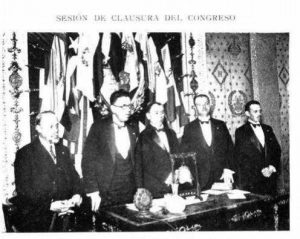
Figure 2. Executive committee of the International Congress, in 1929. Dr. Romero is the third person from the left. (image from El Sol de Meissen).
That same year, Dr. Romero was named honorary president of the International Homeopathic Congress (figures 1 and 2), celebrated between August, 10th and 17th, in the Pan-American Hall of the National Palace in Mexico City. During the course of this meeting, the official presentation of the Spanish version of the sixth edition of the Organon of Medicine took place. This event took place in the auditorium of the Escuela Libre de Homeopatía, on August 13th, 1929 [25] (see figure 3). This work was republished in 1942, to commemorate one hundred years of its elaboration.
Figure 3. Front page of the Organon of Medicine, translated by Dr. Rafael Romero, in 1929.
In tribute to Dr. Romero for his translation of the Organon, the journal The Homeopathic Recorder published his photograph (see figure 4) [26].
Figure 4. Photograph of Dr. Rafael Romero published in The Homeopathic Recorder.
In 1930 Dr. Rafael Romero was chosen to be president of the Mexican Liga Homoeopathica[27]. That same year he published the articles Homeopathy and Allopathy and A Case of a Sebaceous Cyst on the Back [28,29].
He was also a member of the board of directors of the Liga Homoeopathica Medicorum Internationalis, representing Mexico in 1931, as vice president. During this time he published a paper in the journal El Sol de Meissen[30], the same publication in which he was congratulated by Dr. Augusto Vinyals Roig for the translation of the Organon into Spanish, as well as an advertisement to promote this publication (figure 5) [31].
Figure 5. Advertisement of the Spanish version of the Organon of Medicine, published in the journal El Sol de Meissen.
Here is some more biographic information about Dr. Romero:
- In 1931, in addition to promoting the creation of the children’s homeopathic hospital that he had proposed years before[32,33], he became the director of the journal Revista Internacional Homeopática (International Homeopathic Journal) of Mérida, in Yucatán[34].
- In the obituary of Dr. Richard Haehl, published in the journal El Sol de Meissen, in 1932, the translation of the Organon made by Dr. Rafael Romero was mentioned[35].
- Through a letter sent to the International Congress, held in Madrid in 1933, Dr. Romero proposed that a paragraph from Hahnemann’s Organon should be analyzed at each Homeopathy Congress. This proposition was supported by Dr. Pierre Schmidt from Switzerland, who was the first translator of the 6th edition of the Organon into French in 1952. The proposal was approved during the session, on July 27th. By the way, the paragraph to be studied at the Berlin Congress, in 1936, should be the 70th[36].
- In 1935 he served as president of the Section of Homeopathic Philosophy in the VI Pan American Homeopathic Medical Congress, and as president of the Mexican Liga Homoeopathica [37].
- In 1940 the book Estudios de terapéutica homeopática (Studies of homeopathic therapeutics) was published.
- In 1941 he presented the work La enseñanza de la Homeopatía. Necesidad de escuelas y hospitales homeopáticos (The Teaching of Homeopathy. The need for homeopathic schools and hospitals), at the International Congress held in Louisville, Kentucky, USA.
- In 1942 he published two more works: La verdad sobre la terapéutica and Cuál debe ser nuestra actitud respecto a la Homeopatía? (The truth about therapeutics and What should be our attitude towards homeopathy?)
- In 1943, at the request of the government of the state of Yucatan, he collaborated at the Yucatan Encyclopaedia, writing La historia de la medicina homeopática (The History of Homeopathic Medicine). This work was published in volume IV, from page 343 to 407.
- In 1944 he edited the work of Dr. Alfonso Raymundo: La homeopatofobia (Homeopathyphobia)[38].
Dr. Rafael Romero died in his hometown, in 1960, at the age of 80 [39]. His important legacy remains to this day, although with insufficient recognition.
References
- Vinyals Roig A. Congreso Homeopático Internacional, celebrado en Méjico del 10 al 16 de agosto de 1929. El Sol de Meissen. Oct 1929; I(3): 89-115.
- Hahnemann S. El Organon de la Medicina. Ciudad de México: Instituto Politécnico Nacional; 1999. p 11-35. Traducción y comentarios: Flores Toledo D.
- Archivo General del Estado de Yucatán. Acta de nacimiento no. 363, Libro no. 51 de Nacimientos de Mérida, 1882.
- Junta Superior de Sanidad del Estado de Yucatán. Relación de los médicos, farmacéuticos, dentistas, comadronas y enfermeras titulares, legalmente titulados que, conforme al Reglamento de la Medicina y Farmacia en el Estado, están autorizados para ejercer sus respectivas profesiones. En: Documentos para la historia de la revolución. ¡Por Esto!. Disponible en:
- Romero R. Historia de la Medicina Homeopática. En: Enciclopedia Yucatanense, tomo IV, 1a ed. Mérida: Gobierno del Estado de Yucatán; 1943. p. 343-407.
- Picard M Dr. Revue des libres. Le Propagateur de l’Homeopathie. 30 Abr 1908; 4(4): 96.
- Romero R. Op. cit.
- Romero R Dr. Homeopathic remedies hipodermically administered Homeopathic Recorded. Abr 1909; XXIV(5): 264-266.
- Romero R Dr. Confusion of the law of similitude with the channels of introduction and doses of the remedies, a reply to Dr. C. M. Boger, of Parkersburg, and Dr. Pompe, of Vancouver. Homeopathic Recorder. Oct 1909; XXIV(10): 460-466.
- Menéndez Navarrete CR. Los periódicos de Carlos R. Menéndez. Tres cuerpos y un alma, tres cantos y una voz. Diario de Yucatán. 31 May 2000; Editorial.
- Romero R. Op. cit.
- Romero R. Op. cit.
- Domínguez Castro JL. La Universidad Autónoma de Yucatán: un producto de la Revolución Mexicana. Mérida, Yucatán; 2010.
- Romero R. Op. cit.
- Romero R. Op. cit.
- Bello P. Fui en busca de chochitos y encontré una placa con historia. ¡Por Esto! Disponible en:
- Romero R. Op. cit.
- Vinyals Roig A. Congreso Homeopático de Sttutgart. Anales de Homeopatía. 1928 1(1): 6.
- Romero R. Herpes Zoster del brazo izquierdo. Revista Homeopática internacional. Oct 1928: 153.
- Romero R. El uso de los agentes naturales en Homeopatía. Revista Homeopática internacional. Oct 1928: 203-284.
- Romero R. Casos clínicos. Revista Homeopática Internacional. Abr 1929: 23.
- Romero R. Síntomas raros en la influenza. Revista Homeopática Internacional. Abr 1929: 27.
- Romero R. Bibliografía de la literatura homeopática. Revista Homeopática Internacional. Jul-Oct 1929: 37.
- Romero R. Dr. Cordial Invitation. Comunication. The Homeopathic Recorder. 15 Ene 1929: XLI(1). 50.
- Vinyals Roig A. Op.cit. (El Sol de Meissen. Oct 1929; I(3): 89-115., (Referencia1)
- Iconography.The Homeopathic Recorder. 15 Sep 1929: XLIV(9): 592.
- Miscelánea Sección, “La Homeopatia de Méjico” El Sol de Meissen. 1930: II(5): 42.
- Romero R. Homeopatía y alopatía. Revista Internacional Homeopática. Ene 1930: 214.
- Romero R. Un caso de quiste sebáceo de la espalda. Revista Internacional. Ene 1930: 246.
- Romero R. . “ Un año Más” El Sol de Meissen. Abr-May 1931; Año III (9): 398.
- Vinyals Roig A. “La homeopatía es difícil”, El Sol de Meissen. Oct-Dic 1931; Año III (12): 500.
- Romero R. Op. cit. (Referencia 5).
- Vinyals A. Dr. Miscelánea Sección, “Nuevo Hospital Homeopático”, El Sol de Meissen. 1931; III(9): 427.
- Mazari M. .- “Galería de homeópatas ilustres” El Sol de Meissen. Mayo-Junio Año IV (15) 1932: 86.
35.Vinyals Roig Augusto Dr. “El Dr. Richard Hahel ha muerto!” El Sol de Meissen Ene-Feb Año IV (13) 1932:28.
- Programa científico, “Internacionalismo en homeopatía” El Sol de Meissen. Jul-Ago Año V(22) 1933: 300.
- La Homeopatía Mundial, “La Homeopatía en México” El Sol de Meissen, Enero-Febrero Año VII (31) 1935: 239.
- Romero R. Op. Cit. (Referencia 5)
- Hahnemann S. Op. Cit.
@ The article has been puiblished at “La Homeopatia de Mexico”, no.709, July-August 2017.


